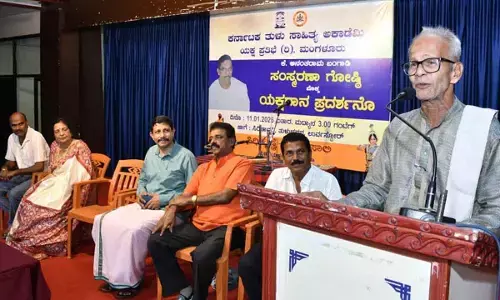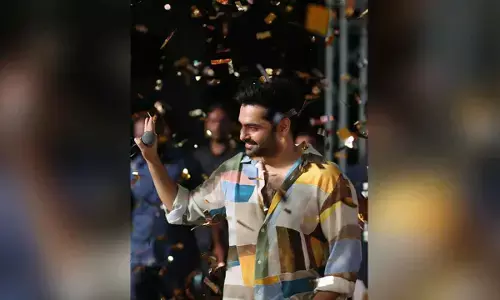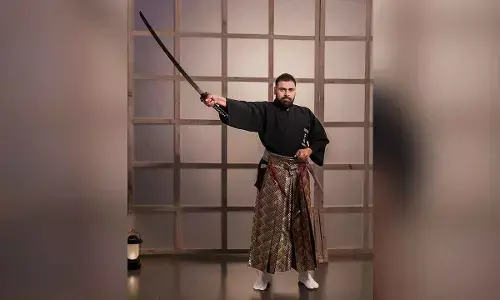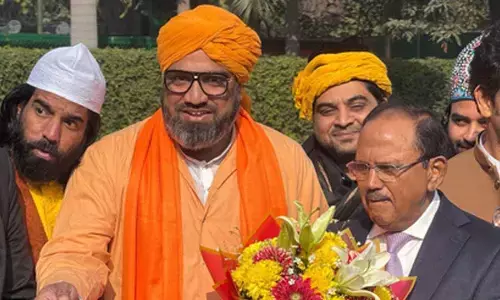A tribute to great scholar

Born on September 24, 1891 near at Gangalakurti near Amalapuram Kakinada District in a middle class family, Bandaru Tammaya rose to become one of the greatest scholars and critics of Saivite literature of Telugus
Born on September 24, 1891 near at Gangalakurti near Amalapuram Kakinada District in a middle class family, Bandaru Tammaya rose to become one of the greatest scholars and critics of Saivite literature of Telugus. He discontinued his studies at High School and joined as clerk in the revenue department. With a rare unswerving devotion to literature, he mastered Telugu, Kannada and Sanskrit languages and earned such titles as ’Eithihasika Samrat,’ ‘Dharma Bhushan,‘ ’Vimarsakagresara’ and ‘Siva Sarana’ and ‘Saiva Sahithi Sarvabhoma’.
He excavated the thousand-year-old Telugu literature and discovered that the Saivite literature had carved out a unique place for itself. With painstaking research, he rehabilitated Palkuriki Somanadha and Pidaparthi poets and dispelled the prejudices over Srinatha’s epicurean life and hedonistic pleasures and proved the contentions of even such literary stalwarts as Veeresalingam wrong. But for his critical acumen and depth of irrefutable scholarship, Srinatha and Palkuriki Somanatha would not have enjoyed a place of primacy along with Nanne Chodudu, Tikkanna, Nachana Somana and Errapragada. Bandaru Tammayya proved that dislodgement of a poet’s place is the very negation of constructive criticism.
The multi-splendored Telugu literature in general and Saivite literature in particular fascinated Tammayya. He was pained to know that Srinatha’s life and works were grossly misrepresented and misinterpreted. No wonder, he was regarded as a competent authority on Srinatha and his ‘Sri Natha Kavi Yugam’ was prescribed as a reference book by the universities in Andhra Pradesh..
Countering the views of well-known critics like Vonguri Subba Rao Pantulu, Veeresalingam, and Veturi Prabhakara Sastry, who painted Srinatha as a poet of unbridled Sringara, Tammayya with his unbiased insight proved that Srinatha was the greatest among Saiva poets. He declared that ‘Kreedabhi Ramam,’ purported to have been written by Srinatha was in fact authored by Vallabha Raya and that the fugitive verses which smack of unbridled Sringara were not scripted by Srinatha. Citing clinching literary and historical evidence, he determined and delivered the judgement that Srinatha, an Aradhya Brahmin, was mistaken for a ‘Niyogi Brahmin.’
Next to his enthronement of Srinatha , Tammayya left no stone unturned to rehabilitate Palkuriki Somanatha. He proved with unmistakable authenticity that Tikkanna and Srinatha learnt the art of exploiting the fertile Telugu idiom in their works from Palkuriki Somanatha. Endowed with the objectivity of a disinterested historian, he challenged and disproved Veeresalingam’s observations on the historicity of Somanatha’s life and proved that Somanatha lived between 1160 and 1240 during the reign of Pratap Rudra. He authored the classic ‘Palkuriki Somanatha Kavi’ with such competence that Madras, Osmania and Andhra Universities prescribed it as a reference book for the graduates and postgraduates.
At a time when the works of eminent poets were cluttered with interpolations, Tammayya took upon himself the arduous task of editing ‘Dwipada Basava Puranam.’ ‘Chaturveda Saram‘ and ‘Laghu Kritis’ ‘Basava Puranam’ and ‘Panditaradhya Charithra’ of Somanatha and restored their primacy in annals of Telugu Literature. With indefatigable zeal, he made a comparative study of all treatises written on Hareeswara Pidaparti Somana and Palkuriki Somana and analysed the prosodic features of Telugu and Kannada classics.
Tammayya was an acclaimed polyglot. His mastery of Sanskrit language and grammar stood him in good stead. He translated such great classics as ‘Raghu Vamsa’ and ‘Kumara Sambhava’, into Telugu prose. His scholarly insight into Kannada Literature helped him do a thorough comparative study of
Telugu and Kannada classics. He put Kannada classics like ’Veera Vivaaha Vidhi’ and ‘Veera Saiva Dersha’ into Telugu. Tammayya’s articles on Basaveswara Literature and its historicity are hailed as authoritative. The ‘Siva Stotra’ of Malhana turned into graceful Telugu prose in his hands. He also contributed a prefatory essay to Umrali Shahi’s book on Prophet Mohammad.
The startling disclosures and revelations he made in his articles roused many a critic from his stupor of dogmatic prejudices. In 1925, Tammayya launched a scathing attack on the votaries of Pina Veerabhadra Kavi in his articles, ‘Pillalamarri Pina Veerabhadra Kavi: Vani Naa Rani.’ Such eminent Avadhanis as Chellapilla Venkata Sastry and Sri Pada Krishna Murty wondered at Tammayya’s extraordinary critical insight and objective analysis. His article ‘Palkuriki Somanadha Kavi Anubhava Saaram’ in the souvenir of Andhra Sahitya Parishad received encomiums from many a discerning critic in 1955.
His ‘Kalyanapuri Prasansa,’ a collection of poems and scholarly speeches on Veera Saiva literature in 1955 at Bangalore, drew the attention of the king of Mysore Jayachama Rajendra Vadayar to the richness of Saivite literature in Telugu. Bandaru Tammayya passed away on 5th December, 1970
– S M Kompella Kakinada
















